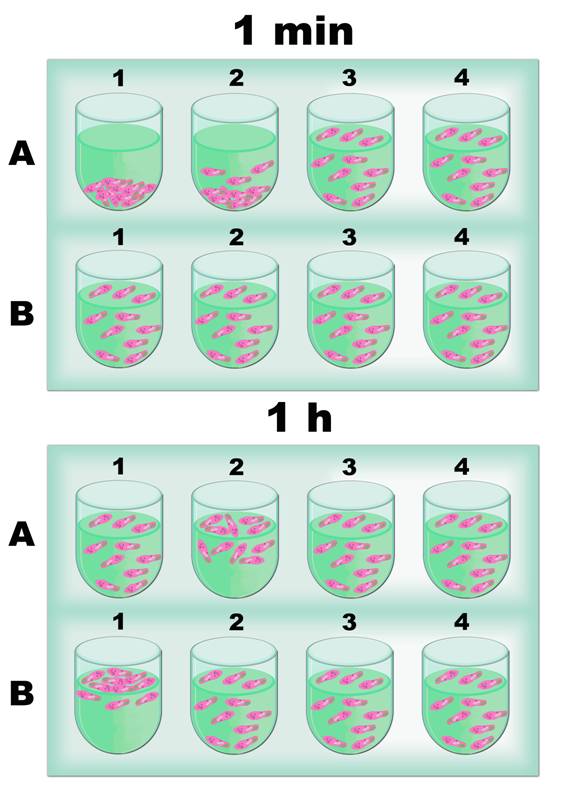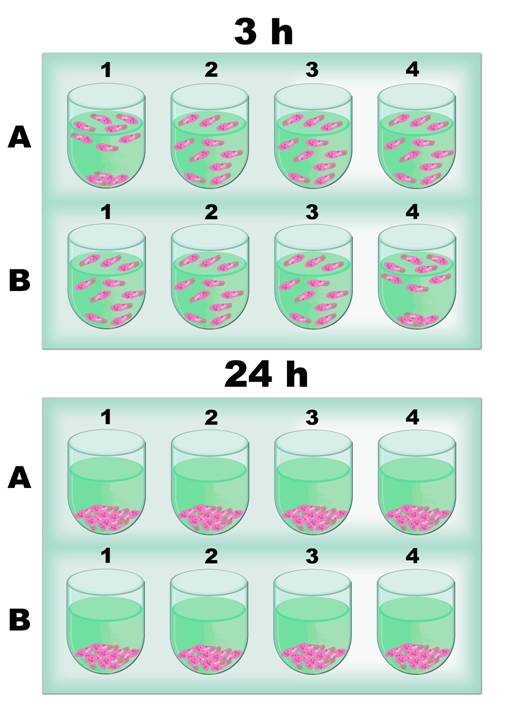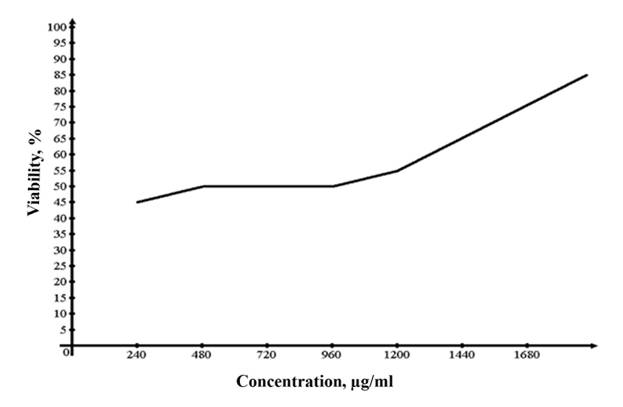BIOLOGICAL EVALUATION OF CHLORELLA RESINOID VIA PARAMECIUM CAUDATUM
Митишев А.В.1, Семенова Е.Ф.2, Величко В.П.3,
Моисеева И.Я.4, Шпичка А.И.5
1 Интерн; 2 Профессор, кандидат биологических наук; 3 Студент; 4 Профессор, доктор медицинских наук; 5 Доцент, кандидат биологических наук, Пензенский государственный университет
БИОЛОГИЧЕСКАЯ ОЦЕНКА РЕЗИНОИДА ХЛОРЕЛЛЫ С ПОМОЩЬЮ ИНФУЗОРИЙ PARAMECIUM CAUDATUM
Аннотация
Цель: исследование действия резиноида хлореллы на культуру инфузорий Paramecium caudatum. Материалы и методы. Объектом исследования являлась культура клеток Paramecium caudatum. Получение резиноида осуществляли согласно а. с. 1638157 (СССР). Результаты. Исследования показали, что после добавления резиноида хлореллы глубинная культура Paramecium caudatum в течение первых 3 часов, в основном, была расположена во всей толще, с преимуществом на поверхности среды. При концентрации резиноида хлореллы 1928 мкг/мл в конце эксперимента (через 24 часа) скорость движения Paramecium caudatum по сравнению с контролем не изменилась, при этом наблюдался наименьший % гибели (15%). При других испытанных концентрациях резиноида в культуральной жидкости (241, 482, 989 мкг/мл) выживаемость тест-культуры составила 50%. Показано отсутствие в составе резиноида токсических веществ.
Ключевые слова: ароматический продукт, биотестирование, инфузория, резиноид хлореллы, токсичность.
Mitishev A.V.1, Semenova E.F.2, Velichko V.P. 3, Moisseva I. Ya. 4, Shpichka A.I.5
1 Intern; 2 Professor, PhD in Biology; 3 Student; 4 Professor, MD; 5 Associate professor, PhD in Biology, Penza State University
BIOLOGICAL EVALUATION OF CHLORELLA RESINOID VIA PARAMECIUM CAUDATUM
Abstract
Objective: The study of the action of chlorella resinoids on the culture of ciliates Paramecium caudatum.
Materials and methods. The object of research is the culture of Paramecium caudatum cells. Getting of resinoids was carried out according to a.c. 1638157 (USSR).
Results. Studies have shown that after adding of resinoids of chlorella culture Paramecium caudatum the culture within the first 3 hours, was mainly located in the entire thickness, on medium surface. At a concentration of chlorella resinoids 1928 mcg / ml at the end of the experiment (24 hours) Paramecium caudatum speed compared with the control is not changed, and the mortality was small (15%). In other resinoids tested concentrations in the culture fluid (241, 482, 989 ug / ml) the test culture survival was 50%. The absence in the resinoids of toxic substances are shown.
Keywords: fragrant product, biotesting, ciliates, chlorella resinoid, toxicity.
Introduction
Resinoids are fragrant fixatives, which are used as odorants and colorants for food, perfumes, cosmetics, household chemicals (1, 2). The traditional source of the resinoid is an oak moss, defined as a lichen Evernia prunastri L., Parmeliaceae family (3). In 2010, International Fragrance Association (IFRA) reduced the rate of the possible concentration of the oakmoss natural products in the perfumes up to 0.02% because of allergic reactions, caused by their component content, and the drop of wild oak moss resources to prevent its extinction.
However, in recent years, their need has increased due to the rise of the world demand. The limitation of the use of the oak moss products gives a goal to develop new technologies, which give a possibility to produce biotechnologically the resinoid (1, 2 4-7). The need for a new aromatic products has recently increased due to the increase in demand for the natural product
Nevertheless, the main question is to find conclusive proofs of its safety for human life and health. (8)
Currently, the practice of biotesting on vitro is popular for the characterization and evaluation of the toxic effect [9]. The test objects are lower organisms [10], ciliates [11, 12]. These methods have a high sensitivity, rapidity, reliability, versatility and low cost [13]. Methodological approaches in studies using ciliates are diverse and depend on each specific case, goals and objectives. In the pharmaceutical, medical, biological and environmental studies, the most popular method is microscopy, it is used in 90% of procedures: as a rule, various modifications of cell count under the microscope [14].
Paramecium caudatum belongs to the kingdom of protists (Protista), Subkingdom of protozoa or unicellular animals (Protozoa), to numerous type of ciliated infusoria Ciliopliora (over 7000 species ) to the genus of Paramecium, species of P. caudatum [15]. A characteristic feature of ciliates is relatively rapid variability, which allows them to adapt to a variety of conditions. As soon as the simplest adapt to environmental conditions, all their vital functions rebuilt (change of speed, rate of reproduction and the ability to absorb the food, as well as the shape and size of the body )[10, 12]. But if the environment does not change, then the properties and reactions of ciliates remain stable. For biotesting analysis the culture in early stationary phase of balance is used.[15]. The purpose of this work: research of actions of chlorella resinoid on culture of infusoria P. caudatum.
The object of the study was 4 daily culture of P. caudatum in the hay infusion, which is washed from the products of metabolism prior to use. Next, a working concentration of ciliates suspension is 100 cells / mL [16]. To do this, cells were counted under a microscope according to generally accepted practice in the microbiological method using a counting Goryaev chamber [17].
The criteria for toxicity were changes in the normal form, movement, distribution character, as well as the number of dead ciliates. The test was performed by two-fold serial dilutions using a 96-well plate. Getting of chlorella resinoid was performed according to a. c. 1638157 (USSR). [18] For analysis the serial dilutions of chlorella resinoid were prepared in concentrations of 0, 96; 1.93; 3.86; 7.71 mg / ml. 0.3 ml of a cell suspension of test -culture in the working concentration was added to the tablet and 0.1 ml of analytical sampler of resinoid in a certain dilution was layered( with pipette). Sample volume was 0.4 ml. Final concentrations of aroma product in cells were as follows: 240.98; 481.91; 988.84; 1927.67 g / ml.
Controls in the experiment were pure culture of P. caudatum (control I) and culture, with the addition of a solvent in the respective serial dilution (control II). The biotesting was carried out during the day. Accounting is carried out after 1 minute, 1, 3, 24 hours on the stereoscopic microscope Biomed MS-2T with increasing of 4.5x lens and eyepiece 10x. Testing was performed in 3 replicates at 24 - 26 ° C.
Results and Discussion
Chlorella resinoid in its structure contains many lipophilic compounds: glycol and phospholipids, sterols, triacylglycerols, fatty acids, and relatively high levels of vitamins, pigments [2]. The degree of toxicity of the aromatic product by testing was determined by functional and structural changes as the most rapid reactions of ciliates, as well as the percentage of surviving ciliates (survival%). After the addition of the investigated aromatic product the following changes in the distribution of P. caudatum were revealed.
1 minute after adding of chlorella resinoid solution at the concentration of 1928 mcg / ml the ciliates formed groups of 10-15 samples formed in the bottom of the wells (Fig. 1).
Fig. 1 – The features of P. caudatum distribution in the wells with the different concentrations (1 – 1928; 2 – 989; 3 – 482; 4 – 241 µg/ml) of the resinoid inside (A) in comparison with the pure culture (B) after 1 min and 1 h
Test-culture showed increased activity, which is manifested in the increase of moving speed compared to the control . In solutions with other concentrations the following changes were observed: ciliates actively moved , almost did not form the clumps, there were single immobile specimens.
An hour after mixing the culture of ciliates in the hay infusion with solutions of different concentrations of Chlorella resinoid it was found that paramecia differ in increased activity, did not form clumps and distributed throughout the thickness of the medium (Fig. 1). This suggests that ciliates P. adapted to the new environment.
After 3 h of study P. caudatum cells were mainly located in the entire thickness, at the surface. The moving speed in comparison with a pure culture has not changed. Protozoa increase in size, did not form cl, there were single immobile specimens (Fig. 2).
Fig. 2 – The features of P. caudatum distribution in the wells with the different concentrations (1 – 1928; 2 – 989; 3 – 482; 4 – 241 µg/ml) of the resinoid inside (A) in comparison with the pure culture (B) after 3 h and 24 h
After 24 hours P. caudatum were in the bottom of wells (Fig. 2). Most of the Protozoa slowly moved. Some paramecium in this period were motionless. The decrease in the number of protozoa and the reduce of their size were noted. There was an increase in the number of P. caudatum in the well at a concentration of chlorella resinoid of 1927 mcg / mL . Dimensions of protozoa were increased. The vast majority of ciliates was still active, but there was a slight decrease in moving activity. This fact can be explained by the fact that bacteria was in progress in the solution of chlorella resinoid and it is a source of food for the ciliates.
Death of P. caudatum per well at a concentration of chlorella resinoid of 1927 mcg / ml was 15%. In the remaining wells the survival rate was 50%. The dependence of death of P. caudatum on the concentration acquired the reversed nature(Fig. 3).
Fig. 3 – Viability of Paramecium caudatum in 24 h of cultivation with the testing substance
Thus, the study showed that chlorella resinoids solution in these concentrations has a stimulating effect on P. caudatum protozoa in the early hours. In subsequent periods of the study there was a decrease of activity, as well as the number of ciliates in 2 times. Paramecia settled on the bottom. The further experiment (day 6-7) showed a dramatic decrease in the number, Protozoa were rare in the field of view of the microscope
Conclusions
The toxicity analysis of the resinoid via the ciliates has shown no toxic effect. The chlorella resinoid possesses stimulating action during first hour of the experiment. In the well with the resinoid concentration 1927 µg/ml, the ciliate speed in the end of experimenthas not changed in comparison with the control 2. It should be noticed that the lowest death rate (15%) was observed in the medium with the resinoid concentration 1927 µg/m. Increasing of the number of paramecium is due to bacteria that are actively developing due to the composition of Chlorella resinoid rich in nutrients.Therefore, the chlorella resinoid influences positively the life activity of Paramecium caudatum.
References
- A.I. Shpichka, Comparative characteristics of the micro-organisms synthesizing de novo the volatile fragrances / AI Shpichka, EF Semenova // Basic Research. - 2013. - № 8 (Part 5). - S. 1113-1124.
- Comparative analysis of producer strains and product innovation as key elements of biotechnology of chlorella resinoid / A.V. Mitishev // Proceedings of the higher educational institutions. Volga region. "Science" series. - 2014. - № 4 (8). - S.19-29.
- Algae, lichens and bryophytes USSR / M.V. Gorlenko.- M .1978. - 365 p.
- A.M. Karpov Development of industrial lines for the production and processing of microalgae /A.M. Karpov, O.N. Albitskaya // Biotechnology. - 1989. - T.5, №3. - S.376-380.
- M.J. Salnikova Chlorella is a new kind of feed / M.J.Salnikova. - M .: Kolos, 1977. - 95 p.
- Roberts S.C. Production and engineering of terpenoids in plant cell culture // Nature Chemical Biology. - 2007. Vol.3. - P. 387-395.
- Commercial Applications of Microalgae / P. Spolaore // Journal of Bioscience and Bioengineering. - 2006. Vol. 101, №6. - P. 201-211.
- Haga N., Haneda K. Paramecium as a bioassay system for elucidation of cytotoxicity and biocompatibility of nanoparticles: effects of carbon nanofibers on proliferation and survival // Jpn. J. Protozool. - 2007. Vol. 40 (2). - P. 139-146.
- D.O. Vinohodov Toxicological studies of feed using the ciliates. - SPb .: AVN, 1995. - 80 p.
- V.E. Kokova Disproportionately flow culture of Protozoe / V.E. Kokova, G.M. Lisowsky. - Novosibirsk: Nauka, 1982. - 188 p.
- A.O. Grozdov Determination of the overall toxicity on infusoria paramecium //. 2001. - № 4. - S. 31-33.
- V.E. Kokova Continuous cultivation of invertebrates / VE Kokova. - Novosibirsk: Nauka, 1982. - 256 p.
- D.O. Vinohodov Biotesting on infusoria cultures in diagnostic prevention of food poisoning of animals (review) // Veterinary Pathology. - 2006. - №1. - S. 90-96.
- Modification of the method of the biological assessment of food with the help of ciliates tetrahimena piriformis / A.D. Ignatiev // Nutrition. - 1980. - №1. - S. 70-71.
- Biotesting analysis - integral method of assessing of the quality of the environment: a teaching aid / A.G. Bubnov - Ivanovo: Publishing House Ivan. Chem-primary State University, 2007. -. 112, p.
- V.D. Turovtsev, V.S. Krasnov Bioindication:. . - Tver: Tver State University , 2004. - 260 p.
- Methods of physiological and biochemical studies of algae in hydrobiological practice / L.A. Sirenko.- K .: Naukova Dumka, 1975. - 247 p.
- AS 1638157 USSR method of producing of microalgae resinoids / P.S. Bugorsky, V.S. Rodov, E.F. Semenova, G.L.Klyachko-Gurvich (USSR). - Claim. 3/22/89 (patent number 4,665,003 from the priority date of the invention, 22.03.1989). Registered in the State Register of Inventions of the USSR 12/01/1990 Publ. 03.30.91, BI number 12.



